|
|
|
Sort Order |
|
|
|
Items / Page
|
|
|
|
|
|
|
| Srl | Item |
| 1 |
ID:
187444
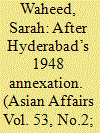

|
|
|
|
|
| Summary/Abstract |
This paper revisits the violent annexation of the erstwhile princely state of Hyderabad by the Indian army in 1948 as an inaugural moment of dispossession to reconstruct Hyderabad's twentieth century past along the axes of Muslim belonging and memory. I argue that we must situate twentieth and twenty-first century Hyderabadi Muslim migration in relation to Partition-related displacements and attempts to overcome them through economic conditions provided by migration. The partition of India prompted waves of migration—such as the later migration of Hyderabadi Muslims to the Persian Gulf in the wake of 1970s oil boom—and their sense of displacement persisted long past the mid-twentieth century, reshaping Muslim notions of belonging. The use of the nation-state as the dominant framework to analyze these shifts is insufficient for understanding Hyderabadi Muslims' sense of belonging and citizenship, which must be also contextualized in terms of upward class mobility along the axes of global and local contexts.
|
|
|
|
|
|
|
|
|
|
|
|
|
|
|
|
| 2 |
ID:
129218
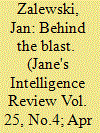

|
|
|
| 3 |
ID:
172000


|
|
|
|
|
| Summary/Abstract |
This article explores the idea of federation in late-colonial India. Projects of federation sought to codify the uncodified and fragmented sovereign landscape of the British Raj. They were ambitious projects that raised crucial questions about sovereignty, kingship, territoriality, the potential of constitutional law in transforming the colonial state into a democratic one, and India's political future more broadly. In the years after 1919, federation became a capacious model for imagining a wide array of political futures. An all-India Indian federation was seen as the most plausible means of maintaining India's unity, introducing representative government, and overcoming the Hindu–Muslim majority–minority problem. By bringing together ‘princely’ India and British India, federation made the Indian states central players in late-colonial contestations over sovereignty. This article explores the role of the states in constitutional debates, their place in Indian political imaginaries, and articulations of kingship in late-colonial India. It does so through the example of Hyderabad, the premier princely state, whose ruler made an unsuccessful bid for independence between 1947 and 1948. Hyderabad occupied a curious position in competing visions of India's future. Ultimately, the princely states were a decisive factor in the failure of federation and the turn to partition as a means of overcoming India's constitutional impasse.
|
|
|
|
|
|
|
|
|
|
|
|
|
|
|
|
| 4 |
ID:
131774


|
|
|
|
|
| Publication |
2014.
|
| Summary/Abstract |
Drawing on twelve months of fieldwork in suburban Hyderabad, this paper explores the double binds experienced by middle-class young women as they attempt to meet the competing demands of 'respectable' and 'fashionable' femininity. For middle-class women, respectability requires purposeful movement, demure posture and modest clothing when in public, as well as avoidance of lower-class spaces where men congregate. Status can, however, also be achieved through more revealing fashionable clothing and consumption in elite public spaces. Whilst respectability for some sections of the middle class necessitates avoidance of even platonic relationships with the opposite sex, upper middle-class informants encourage heterosociality and for some upper middle-class and elite youth pre-marital romance is a form of 'fashion' due to its location in high-status spaces of leisure and consumption. The tensions described in this paper reveal the fragmentation of Hyderabad's middle class and the barriers to social mobility experienced by women for whom the relationship between legitimate cultural capital and feminine modesty is becoming increasingly complex.
|
|
|
|
|
|
|
|
|
|
|
|
|
|
|
|
| 5 |
ID:
182848


|
|
|
|
|
| Summary/Abstract |
The city of Hyderabad has had a distinct linguistic and political history. It was a multilingual city with Urdu (and Persian) as the court languages under the Asaf Jahi dynasty until 1948, when it was annexed by the Indian union. While Hyderabad continues to be multilingual with Telugu, Urdu, Marathi, Kannada and Tamil being spoken in the city, its identity has undergone many changes. It became the Telugu capital city with the formation of Andhra Pradesh state in 1956. In 2014, it became the capital of the newly-formed Telangana state and Urdu was added to Telugu as the official language of the state in 2017. This article examines the transforming image of the city as constructed by Urdu, Telugu and Deccani language films from the 1950s to the present. Reading these films for the discourse on the city, it argues that each addressed its own imagined audience, claimed a specific identity for the city and invisiblised all others. The schism of representation reflected in the films is rooted in the city’s historical past and its multiple contested identities.
|
|
|
|
|
|
|
|
|
|
|
|
|
|
|
|
| 6 |
ID:
001009


|
|
|
|
|
| Publication |
New Delhi, Manohar, 1991.
|
| Description |
95p.: ill., maps.Hbk
|
| Standard Number |
818542554X
|
|
|
|
|
|
|
|
|
|
|
|
Copies: C:1/I:0,R:0,Q:0
Circulation
| Accession# | Call# | Current Location | Status | Policy | Location |
| 040519 | 923.854/KHA 040519 | Main | On Shelf | General | |
|
|
|
|
| 7 |
ID:
102044


|
|
|
|
|
| Publication |
2011.
|
| Summary/Abstract |
Whilst the history of the Indian diaspora after independence has been the subject of much scholarly attention, very little is known about non-Indian migrants in India. This paper traces the fate of Arabs, Afghans and other Muslim migrants after the forcible integration of the princely state of Hyderabad into the Indian Union in 1948. Because these non-Indian Muslims were doubly marked as outsiders by virtue of their foreign birth and their religious affiliation, the government of India wished to deport these men and their families. But the attempt to repatriate these people floundered on both political and legal shoals. In the process, many were left legally stateless. Nonetheless, migrants were able to creatively change the way they self-identified both to circumvent immigration controls and to secure greater privileges within India.
|
|
|
|
|
|
|
|
|
|
|
|
|
|
|
|
| 8 |
ID:
032062
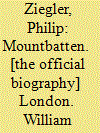

|
|
|
|
|
| Publication |
London, William Collins sons and Co. Ltd., 1985.
|
| Description |
786p.Hbk
|
| Standard Number |
0002165430
|
|
|
|
|
|
|
|
|
|
|
|
Copies: C:1/I:0,R:0,Q:0
Circulation
| Accession# | Call# | Current Location | Status | Policy | Location |
| 025510 | 923.142/ZIE 025510 | Main | On Shelf | General | |
|
|
|
|
| 9 |
ID:
179993
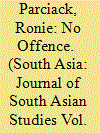

|
|
|
|
|
| Summary/Abstract |
This essay addresses canonisation accounts of the medieval Muslim saint Hazrat Sharafuddin Hyderabadi. According to a contemporary text, a Hindu deity was believed to have been jettisoned from the saint’s dargah, causing communal unrest in the Deccan. How can a Muslim saint be enshrined through offence in a Hindu environment, and how does this create a discourse of both rifts and bridges between Hinduism and Islam in contemporary India? The analysis traces the interdependence between the Muslim and Hindu communities and suggests a more nuanced reading than positions advanced in the current political climate and in recent legislation, which consider them to be irreconcilable socio-religious systems.
|
|
|
|
|
|
|
|
|
|
|
|
|
|
|
|
| 10 |
ID:
093929


|
|
|
| 11 |
ID:
078476
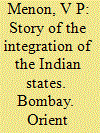

|
|
|
|
|
| Publication |
Bombay, Orient Longmans, 1961.
|
| Description |
489p.hbk
|
|
|
|
|
|
|
|
|
|
|
|
Copies: C:1/I:0,R:0,Q:0
Circulation
| Accession# | Call# | Current Location | Status | Policy | Location |
| 000174 | 954.04/MEN 000174 | Main | On Shelf | General | |
|
|
|
|
| 12 |
ID:
123067


|
|
|
|
|
| Publication |
2013.
|
| Summary/Abstract |
This paper examines the rise of urban space as locus of intervention, and planning as modality of state power in South Asia from the late nineteenth century to the early post-colonial period. I view these developments through the re-making of Hyderabad, a major metropolis and capital of a sovereign non-colonial state until 1948. The regime's autonomous status made the city a venue for political experimentations informed by varied global and regional circuits. A particular develomentalist idiom fusing an older ideology of ethical patrimonialism and emerging technocratic legitimising rhetorics underwrote planning work in Hyderabad. Tracing urban expansion, housing and infrastructural development, and state-led economic planning schemes, I suggest Hyderabad exemplifies the emergence of a crucial and enduring new form of power in South Asia.
|
|
|
|
|
|
|
|
|
|
|
|
|
|
|
|
| 13 |
ID:
145543


|
|
|
|
|
| Publication |
New Delhi, Oxford University Press, 2016.
|
| Description |
xx, 314p.: tables, figureshbk
|
| Standard Number |
9780199464166
|
|
|
|
|
|
|
|
|
|
|
|
Copies: C:1/I:0,R:0,Q:0
Circulation
| Accession# | Call# | Current Location | Status | Policy | Location |
| 058691 | 333.9105/NAR 058691 | Main | On Shelf | General | |
|
|
|
|
|
|
|
|
|